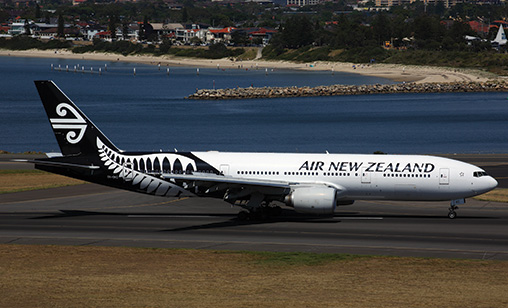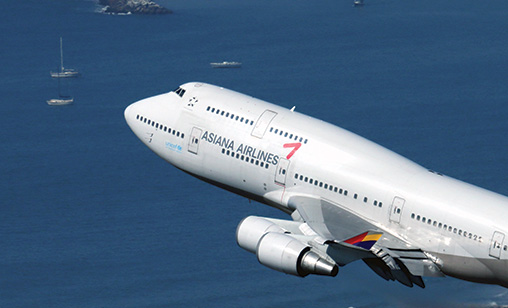Main Story
Is tracking on track?
On March 8, 2014, the world was shocked to learn that Malaysia Airlines flight MH370, a sophisticated jet aircraft with 239 crew and passengers on board, had disappeared into thin air. To ensure such a tragic accident would never be repeated, new aircraft tracking rules will come into effect in November next year.
April 1st 2017
Asia-Pacific airlines and air navigation service providers are among the earliest adopters of the technology necessary to conform to the International Civil Aviation Organisation’s (ICAO) upgraded aircraft tracking regulations. Read More »
The latest Asia-Pacific airlines to lock in a deal that will track their fleets anywhere and at any time in the world are South Korea’s Asiana Airlines and its budget subsidiary, Air Busan.
 |
In February, they signed up to install Rockwell Collins’ Arinc MultiLink aircraft tracking service, which brings together multiple data sources to report the location of a commercial aircraft anywhere in the world, particularly over remote land and oceanic spaces.
“Proactively tracking our aircraft ensures we have the most up-to-date information to manage our complex flight operations,” said IT service manager of Operations Control at Asiana, Kyungsuk Jun.
“We are anticipating the seamless integration of Rockwell Collins’ Arinc MultiLink data feeds into our situational display system will enable us to track our aircraft anywhere in the world.”
Asiana and Air Busan are the latest of the region’s carriers to ensure they will meet ICAO’s November 2018 deadline for more frequent monitoring of the global airline fleet. Since the 2014 disappearance of MH370, carriers worldwide have been moving towards meeting new ICAO rules on tracking.
From that date, all aircraft must be tracked every 15 minutes. In addition, from January 2021, they must have systems that will autonomously transmit an aircraft’s position at least once every minute when it is in distress.
Nearly all the region’s major legacy carriers either have met the upgraded tracking standards or have ordered systems to conform to the ICAO deadline. Many airports and Air Navigation Service Providers (ANSP) across the region also are well ahead of schedule in upgrading their tracking capabilities.
Hundreds of the latest generation of jets scheduled for delivery - from the A350 and the A320neo to the B787, B777 and B737 MAX families- are being assembled with the required equipment on board, although some tracking systems will require additional hardware to be installed in time for the implementation of the ICAO standard.
The Civil Aviation Authority of Singapore, in partnership with Aireon, announced as far back as 2015 that it would commence operation of an automatic dependent surveillance-broadcast (ADS-B) system that uses satellites to monitor all flights in real time.
| 'Airlines choose their providers. Finding a cost effective system that meets the new ICAO regulations and also accommodates rapid developments in tracking technology is a challenge' |
The Indian government instructed its airlines to track planes in real time in 2014, soon after MH370 disappeared. Inmarsat has been working with Airservices Australia and Qantas and Virgin Australia to develop an operational concept for the use of Automatic Dependent Surveillance – Contract (ADS-C) satellite technology over Australia’s oceanic regions. Airservices Australia was the first ANSP to trial the ICAO standard, using Inmarsat’s global flight tracking service.
Airlines choose their providers. Finding a cost effective system that meets the new ICAO regulations and also accommodates rapid developments in tracking technology is a challenge. Also, the tracking market is highly competitive as existing and entry companies strive to lock in customers for their systems.
What is available now or soon will be?
Aireon, a subsidiary of satellite operator Iridium, announced last month that Thales has officially begun the testing and validation of its space-based ADS-B data. The start of data validation marks a major milestone for the efforts of Aireon and Thales to successfully integrate space-based ADS-B into the TopSky–ATC automation platform.
The Aireon service will be operational in 2018, shortly after the completion of the Iridium NEXT satellite constellation. In January, the first ten Iridium NEXT satellites carrying the Aireon ADS-B hosted pay load were successfully launched from Vandenberg Air Force Base in California on a SpaceX Falcon 9 rocket.
The constellation will consist of 66 operational low-Earth-orbit satellites that will provide global coverage. The service also will deliver to ANSPs global aircraft surveillance capability. The system will reduce aircraft operating costs by determining the most efficient flight paths for airlines en route to their destinations.
“We have been working strategically with Thales for over two years to implement a robust third party data validation set of processes and procedures,” said Aireon chief executive, Don Thoma.
 |
“Thales is a leading air traffic management automation platform provider and we want to ensure that space-based ADS-B will be incorporated seamlessly into the system. Thales will have a direct connection to our service delivery point and will be ready to go live with the Aireon data when we are operational in 2018.”
Asiana’s newly ordered system, in addition to utilizing Rockwell Collins’ proprietary high-frequency data link (HFDL) performance data, merges ACARS position reports, ADS-C, ADS-B, ASDI radar data and EuroControl position information.
Arinc MultiLink is designed to receive notifications when an aircraft has unexpectedly stopped reporting positional data or when it has deviated from its expected flight path.
“As a carrier that focuses on providing our passengers with the lowest airfares possible, we find Arinc MultiLink to be a highly economical solution for global aircraft tracking because it did not require us to add on board hardware on our aircraft,” Air Busan Operations Control Center leader, Hyeonmin Lee, said.
Another flight tracking company, Texas-based FlightAware, has partnered with Aireon. It has announced its GlobalBeacon tracking system, using 81 ADS-B receivers aboard a constellation of satellites last year.
“This is the most significant advance in flight tracking since radar was invented in World War II and will soon provide the first and only truly global flight tracking system, including coverage over the North and South poles as well as every ocean and every desert in the world,” declared FlightAware chief executive Daniel Baker.
He said the system meets the long standing challenge of “getting various pieces of technology together” to meet the needs of a wide range of aircraft operator customers, who will be able to incorporate the new “near real-time” tracking capability into their operations without any equipment upgrades.
Airline-owned communications and IT provider, SITAONAIR, has been in the aircraft tracking sector since 2014 with its AIRCOM Server Flight Tracker solution. The system allows airlines to track aircraft movements by merging SITAONAIR’s airline dispatcher centre system and airline operations centre system (AIRCOM) Server, with its Future Air Navigation System (FANS) ground application, which is available to ANSPs.
| 'For airlines, whatever the initial cost, there will be a silver lining. A study released at the World ATM Congress in Madrid in March said satellite cockpit communications (satcom) had saved airlines more than $3 billion in the last 15 years' |
The advantage of the FANS system is it has been installed on large numbers of airliners, which makes it less expensive than other offerings.
In 2016, Panasonic Avionics announced it would offer global tracking to all its Satcom customers that would “seamlessly enable flight tracking on more than 1,500 aircraft. We expect to extend this capability to above 3,500 aircraft in the short term,” it said.
Last December, the U.S.’s Spire Global announced its entry into the aircraft tracking market because of technology available from its constellation of satellites monitoring maritime traffic and weather patterns.
Spire Global said it could add aircraft on its tracking capability by installing additional sensors on its future satellites. Spire expected to launch 25 satellites carrying ADS-B payloads by year end with 50 to follow in 2018. It now operates 16 satellites. Although it did not disclose pricing for its ADS-B service, it indicated it would be less expensive than some competitors.
Innovative New Zealand satellite and cellular communication company, Flightcell International, unveiled its next-generation tracking technology at a helicopter-focused Expo in Dallas, Texas last month.
Described as high-frequency low-cost tracking using Internet Protocol (IP) over cellular broadband, the company said it offers more precise tracking than satellite rivals by dramatically increasing the number of GPS positions sent from an aircraft.
This is achieved at a significantly lower cost than traditional tracking. Cellular IP Tracking uses cellular broadband data services and IP routing instead of cellular SMS or satellite data services.
When out of cellular range tracking automatically switches to an Iridium satellite and the reverse applies when a cellular network is available. When tracking via satellite the frequency of the position points automatically decreases to keep costs down.
Other participants in the global flight tracking system market are SkyTrac Systems, FlightStats, Spidertracks, Blue Sky Network and FLYHT.
Industry experts caution that upgrading in tune with technological advances is challenging.
Putting a new tracking device on an aircraft, if that is necessary, does not happen quickly because additional equipment must go through procedural and regulatory processes before it is validated for installation.
Another issue to note is that new tracking equipment will need battery back-up because the tracking technology already on aircraft operates from the airliner’s main power source.
There are no specific figures for the value of the aircraft tracking business, but the global flight tracking system market is expected to increase in value by up to 10% annually over the next decade.
For airlines, whatever the initial cost, there will be a silver lining. A study released at the World ATM Congress in Madrid last month said that satellite cockpit communications (satcom) had saved airlines more than $3 billion in the last 15 years.
Conducted by aviation consultancy, Helios, on behalf of satcom service provider, Inmarsat, the study said satcoms improved safety and airline operating efficiency and that these benefits applied particularly to carriers flying over vast oceanic air spaces.
A single air traffic control (ATC) benefit mechanism - reducing longitudinal separation minima from 100 nautical miles to 30 nautical miles - saved US$890 million between 2001 and 2016, said Helios. More reliable communications and tracking produced the savings.
| ICAO’s date line for upgraded aircraft tracking International Air Transport Association (IATA) director flight operations, Atholl Buchan, said many airlines already track their aircraft through a variety of means. “IATA, airlines and other stakeholders have worked with ICAO to develop a tracking standard and accompanying performance-based Standards and Recommended Practices,” he said. “These become effective in July 2017 and will be applicable from November 2018, at which point airlines will be required to track their aircraft in oceanic airspace (and recommended elsewhere) at a time interval of every 15 minutes. “In a few years, new systems and technology, if adopted universally by ANSPs, will allow for global surveillance coverage. The adopted standard takes this into account.” |